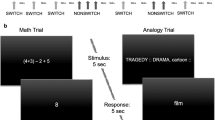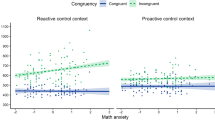Abstract
Stroop tasks are considered useful in assessing anxious affect. Although symptomatically mathematics anxiety is similar to other anxiety conditions, demonstrating a Stroop interference effect among individuals with math anxiety has proven difficult. High and low math anxious individuals were administered a Stroop-like card task involving the counting of numerals and letters, along with a standard computer-based Stroop color-naming task using mathematical and neutral control words. On the card task, processing time was significantly longer among high math anxious participants, an effect most pronounced in the numeral condition. Response time did not differ on the standard Stroop color-naming task as a function of anxiety group or word type. Results suggest that interference effects of math anxiety may be a function of inhibitory deficits or excitatory processes (or both) that are compounded when exposed to more salient (i.e. numeric) stimuli. Implications regarding the assessment of mathematics anxiety and Stroop task methodology are discussed.
Similar content being viewed by others
REFERENCES
Ashcraft, M. H., & Faust, M. W. (1994). Mathematics anxiety and mental arithmetic performance: An exploratory investigation. Cognition and Emotion, 8, 97–125.
Ashcraft, M. H., Kirk, E., & Hopko, D. R. (1998). On the cognitive consequences of mathematics anxiety. In C. Donlan (Ed.), The development of mathematical skills (pp. 175–199). London: UCL Press.
Bush, G., Whalen, P. J., Rosen, B. R., Jenike, M. A., McInerney, S. C., & Rauch, S. L. (1998). The counting Stroop: An interference task specialized for functional neuroimaging - Validation study with functional MRI. Human Brain Mapping, 6, 270–282.
Cassiday, K. L., McNally, R. J., & Zeitlin, S. B. (1992). Cognitive processing of trauma cues in rape victims with post-traumatic stress disorder. Cognitive Therapy and Research, 16, 283–295.
Cohen, J. D., Dunbar, K., & McClelland, J. L. (1990). On the control of automatic processes: A parallel distributed processing account of the Stroop effect. Psychological Review, 97, 332–361.
Eysenck, M. W., & Calvo, M. G. (1992). Anxiety and performance: The processing efficiency theory. Cognition and Emotion, 6, 409–434.
Foa, E.B., Ilai,D., McCarthy, P. R., Shoyer, B., & Murdock, T. (1993). Information processing in obsessive- compulsive disorder. Cognitive Therapy and Research, 17, 173–189.
Freeman, T. J., & Lattal, K. A. (1992). Stimulus control of behavioral history. Journal of the Experimental Analysis of Behavior, 57, 5–15.
Holle, C., Neely, J. H., & Heimberg, R. G. (1997). The effects of blocked versus random presentation and semantic relatedness of stimulus words on response to a modified Stroop task among social phobics. Cognitive Therapy and Research, 21, 681–697.
Hopko, D. R., Ashcraft, M. H., Gute, J., Ruggiero, K. J., & Lewis, C. (1998). Mathematics anxiety and working memory: Support for the existence of a deficient inhibition mechanism. Journal of Anxiety Disorders, 12, 343–355.
MacLeod, C. M. (1991). Half a century of research on the Stroop effect: An integrative review. Psychological Bulletin, 109, 163–203.
Masia, C. L., McNeil, D. W., Cohn, L. G., & Hope, D. A. (in press). Exposure to social anxiety words: Treatment for social phobia based on the Stroop paradigm. Cognitive and Behavioral Practice.
McLaughlin, M. S. (1996). Comparison of a self-report questionnaire and a Stroop color-naming task. Unpublished senior thesis. Oklahoma State University.
McNally, R. J., Kaspi, S. P., Riemann, B. C., & Zeitlin, S. B. (1990). Selective processing of threat cues in posttraumatic stress disorder. Journal of Abnormal Psychology, 99, 398–402.
McNeil, D.W., Ries, B. J., Taylor, L. J., Boone, M. L., Carter, L. E., Turk, C. L., et al. (1995). Comparison of social phobia subtypes using Stroop tests. Journal of Anxiety Disorders, 9, 47–57.
Morton, J. (1969). Categories of interference:Verbal mediation and conflict in card sorting. British Journal of Psychology, 60, 329–346.
Phaf, R. H., Christoffels, I. K., Waldorp, L. J., & den Dulk, P. (1998). Connectionist investigations of individual differences in Stroop performance. Perceptual and Motor Skills, 87, 899–914.
Plake, B. S., & Parker, C. S. (1982).The development and validation of a revised version of the Mathematics Anxiety Rating Scale. Educational and Psychological Measurement, 42, 551–557.
Richardson, F. C., & Suinn, R. M. (1972). The Mathematics Anxiety Rating Scale. Journal of Counseling Psychology, 19, 551–554.
Spielberger, C. D. (1977). The Test Anxiety Inventory. Palo Alto, CA: Consulting Psychologists Press.
Spielberger, C.D., Gorsuch, R., Lushene, R., Vagg, P. R., & Jacobs, G.A. (1983). Manual for the State-Trait Anxiety Inventory. Palo Alto: Consulting Psychologists Press.
Stroop, J. R. (1935). Studies of interference in serial verbal reactions. Journal of Experimental Psychology, 18, 643–661.
Watson, D., & Friend, R. (1969). Measurement of social-evaluative anxiety. Journal of Consulting and Clinical Psychology, 33, 448–457.
Williams, J. M., Mathews, A., & MacLeod, C. (1996). The emotional Stroop task and psychopathology. Psychological Bulletin, 120, 3–24.
Windes, J.D. (1968). Reaction t ime for numerical coding and naming of numerals. Journal of Experimental Psychology, 78, 318–322.
Author information
Authors and Affiliations
Rights and permissions
About this article
Cite this article
Hopko, D.R., McNeil, D.W., Gleason, P.J. et al. The Emotional Stroop Paradigm: Performance as a Function of Stimulus Properties and Self-Reported Mathematics Anxiety. Cognitive Therapy and Research 26, 157–166 (2002). https://doi.org/10.1023/A:1014578218041
Issue Date:
DOI: https://doi.org/10.1023/A:1014578218041




